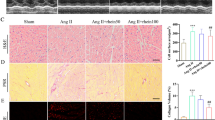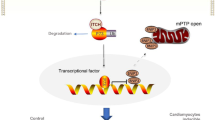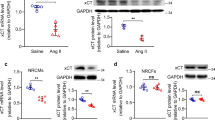Abstract
Zinc finger and BTB domain-containing protein 20 (ZBTB20) play an important role in glucose and lipid homeostasis. ZBTB20 was shown to be a crucial protein for the maintenance of cardiac contractile function. However, the role of ZBTB20 in cardiac response remodeling has not been elucidated. Thus, this study aimed to explore the role of ZBTB20 in cardiac remodeling following angiotensin II insult. Mice were subjected to angiotensin II infusion to induce a cardiac adverse remodeling model. An adeno-associated virus (AAV) 9 system was used to deliver ZBTB20 to the mouse heart. Here, we demonstrate that ZBTB20 expression is elevated in angiotensin II-induced cardiac remodeling and in response to cardiomyocyte insults. Furthermore, AAV9-mediated overexpression of ZBTB20 caused cardiac wall hypertrophy, chamber dilation, increased fibrosis, and reduced ejection fraction. Additionally, ZBTB20 siRNA protected cardiomyocytes from angiotensin II-induced hypertrophy. Mechanistically, ZBTB20 interferes with EGFR and Akt signaling and modulates the remodeling response. Overexpression of constitutively active Akt counteracts ZBTB20 knockdown-mediated protection of adverse cardiac remodeling. These findings illustrate the role of ZBTB20 in the transition of adverse cardiac remodeling toward heart failure and provide evidence for the molecular programs inducing adverse cardiac remodeling.
Key messages
-
ZBTB20 is a transcription factor from the POK family.
-
ZBTB20 is upregulated in heart tissue treated with angiotensin II.
-
ZBTB20 influences cardiomyocyte hypertrophy via the EGFR-Akt pathway.
-
Akt continuous activation leads to similar results to ZBTB20 overexpression.







Similar content being viewed by others
Availability of data and material
All data will be available upon request from the corresponding author.
References
Schuttler D, Clauss S, Weckbach LT, Brunner S (2019) Molecular mechanisms of cardiac remodeling and regeneration in physical exercise. Cells 8:1128. https://doi.org/10.3390/cells8101128
Ames MK, Atkins CE, Pitt B (2019) The renin-angiotensin-aldosterone system and its suppression. J Vet Intern Med 33:363–382. https://doi.org/10.1111/jvim.15454
Rossignol P, Hernandez AF, Solomon SD, Zannad F (2019) Heart failure drug treatment. Lancet 393:1034–1044. https://doi.org/10.1016/S0140-6736(18)31808-7
Grisanti LA, Guo S, Tilley DG (2017) Cardiac GPCR-mediated EGFR transactivation: impact and therapeutic implications. J Cardiovasc Pharmacol 70:3–9. https://doi.org/10.1097/FJC.0000000000000462
Liang D, Zhong P, Hu J, Lin F, Qian Y, Xu Z, Wang J, Zeng C, Li X, Liang G (2015) EGFR inhibition protects cardiac damage and remodeling through attenuating oxidative stress in STZ-induced diabetic mouse model. J Mol Cell Cardiol 82:63–74. https://doi.org/10.1016/j.yjmcc.2015.02.029
Liu L, Jin X, Hu CF, Zhang YP, Zhou Z, Li R, Shen CX (2018) Amphiregulin enhances cardiac fibrosis and aggravates cardiac dysfunction in mice with experimental myocardial infarction partly through activating EGFR-dependent pathway. Basic Res Cardiol 113:12. https://doi.org/10.1007/s00395-018-0669-y
Liu X, Lin L, Li Q, Ni Y, Zhang C, Qin S, Wei J (2019) ERK1/2 communicates GPCR and EGFR signaling pathways to promote CTGF-mediated hypertrophic cardiomyopathy upon Ang-II stimulation. BMC Mol Cell Biol 20:14. https://doi.org/10.1186/s12860-019-0202-7
Zuo C, Li X, Huang J, Chen D, Ji K, Yang Y, Xu T, Zhu D, Yan C, Gao P (2018) Osteoglycin attenuates cardiac fibrosis by suppressing cardiac myofibroblast proliferation and migration through antagonizing lysophosphatidic acid 3/matrix metalloproteinase 2/epidermal growth factor receptor signalling. Cardiovasc Res 114:703–712. https://doi.org/10.1093/cvr/cvy035
Doeppner TR, Herz J, Bahr M, Tonchev AB, Stoykova A (2019) Zbtb20 regulates developmental neurogenesis in the olfactory bulb and gliogenesis after adult brain injury. Mol Neurobiol 56:567–582. https://doi.org/10.1007/s12035-018-1104-y
Liu G, Zhou L, Zhang H, Chen R, Zhang Y, Li L, Lu JY, Jiang H, Liu D, Qi S et al (2017) Regulation of hepatic lipogenesis by the zinc finger protein Zbtb20. Nat Commun 8:14824. https://doi.org/10.1038/ncomms14824
Sun Y, Preiss NK, Valenteros KB, Kamal Y, Usherwood YK, Frost HR, Usherwood EJ (2020) Zbtb20 restrains CD8 T cell immunometabolism and restricts memory differentiation and antitumor immunity. J Immunol 205:2649–2666. https://doi.org/10.4049/jimmunol.2000459
Zhang Y, Zhou X, Zhang M, Cheng L, Zhang Y, Wang X (2019) ZBTB20 promotes cell migration and invasion of gastric cancer by inhibiting IkappaBalpha to induce NF-kappaB activation. Artif Cells Nanomed Biotechnol 47:3862–3872. https://doi.org/10.1080/21691401.2019.1670188
Zhang H, Shi JH, Jiang H, Wang K, Lu JY, Jiang X, Ma X, Chen YX, Ren AJ, Zheng J et al (2018) ZBTB20 regulates EGFR expression and hepatocyte proliferation in mouse liver regeneration. Cell Death Dis 9:462. https://doi.org/10.1038/s41419-018-0514-0
Ren AJ, Chen C, Zhang S, Liu M, Wei C, Wang K, Ma X, Song Y, Wang R, Zhang H et al (2020) Zbtb20 deficiency causes cardiac contractile dysfunction in mice. FASEB J 34:13862–13876. https://doi.org/10.1096/fj.202000160RR
Karbach SH, Schonfelder T, Brandao I, Wilms E, Hormann N, Jackel S, Schuler R, Finger S, Knorr M, Lagrange J et al (2016) Gut microbiota promote angiotensin II-induced arterial hypertension and vascular dysfunction. J Am Heart Assoc 5:e003698. https://doi.org/10.1161/JAHA.116.003698
Kvakan H, Kleinewietfeld M, Qadri F, Park JK, Fischer R, Schwarz I, Rahn HP, Plehm R, Wellner M, Elitok S et al (2009) Regulatory T cells ameliorate angiotensin II-induced cardiac damage. Circulation 119:2904–2912. https://doi.org/10.1161/CIRCULATIONAHA.108.832782
Muller DN, Dechend R, Mervaala EM, Park JK, Schmidt F, Fiebeler A, Theuer J, Breu V, Ganten D, Haller H et al (2000) NF-kappaB inhibition ameliorates angiotensin II-induced inflammatory damage in rats. Hypertension 35:193–201. https://doi.org/10.1161/01.hyp.35.1.193
Zong J, Li FF, Liang K, Dai R, Zhang H, Yan L, Liu JL, Xu LH, Qian WH (2018) Nuclear localization leucine-rich-repeat protein 1 deficiency protects against cardiac hypertrophy by pressure overload. Cell Physiol Biochem 48:75–86. https://doi.org/10.1159/000491664
Li F, Zhang H, Yang L, Yong H, Qin Q, Tan M, Xu L, Liang K, Zong J, Qian W (2018) NLRP3 deficiency accelerates pressure overload-induced cardiac remodeling via increased TLR4 expression. J Mol Med (Berl) 96:1189–1202. https://doi.org/10.1007/s00109-018-1691-0
Nakamura M, Sadoshima J (2018) Mechanisms of physiological and pathological cardiac hypertrophy. Nat Rev Cardiol 15:387–407. https://doi.org/10.1038/s41569-018-0007-y
Shimizu I, Minamino T (2016) Physiological and pathological cardiac hypertrophy. J Mol Cell Cardiol 97:245–262. https://doi.org/10.1016/j.yjmcc.2016.06.001
Shindo T, Manabe I, Fukushima Y, Tobe K, Aizawa K, Miyamoto S, Kawai-Kowase K, Moriyama N, Imai Y, Kawakami H et al (2002) Kruppel-like zinc-finger transcription factor KLF5/BTEB2 is a target for angiotensin II signaling and an essential regulator of cardiovascular remodeling. Nat Med 8:856–863. https://doi.org/10.1038/nm738
Pan L, Sheng M, Huang Z, Zhu Z, Xu C, Teng L, He L, Gu C, Yi C, Li J (2017) Zinc-finger protein 418 overexpression protects against cardiac hypertrophy and fibrosis. PLoS One 12:e0186635. https://doi.org/10.1371/journal.pone.0186635
de Vicente LG, Pinto AP, da Rocha AL, Pauli JR, de Moura LP, Cintra DE, Ropelle ER, da Silva ASR (2020) Role of TLR4 in physical exercise and cardiovascular diseases. Cytokine 136:155273. https://doi.org/10.1016/j.cyto.2020.155273
Shah S, Akhtar MS, Hassan MQ, Akhtar M, Paudel YN, Najmi AK (2018) EGFR tyrosine kinase inhibition decreases cardiac remodeling and SERCA2a/NCX1 depletion in streptozotocin induced cardiomyopathy in C57/BL6 mice. Life Sci 210:29–39. https://doi.org/10.1016/j.lfs.2018.08.018
Childers CL, Tessier SN, Storey KB (2019) The heart of a hibernator: EGFR and MAPK signaling in cardiac muscle during the hibernation of thirteen-lined ground squirrels. Ictidomys tridecemlineatus PeerJ 7:e7587. https://doi.org/10.7717/peerj.7587
Peng K, Tian X, Qian Y, Skibba M, Zou C, Liu Z, Wang J, Xu Z, Li X, Liang G (2016) Novel EGFR inhibitors attenuate cardiac hypertrophy induced by angiotensin II. J Cell Mol Med 20:482–494. https://doi.org/10.1111/jcmm.12763
Smith NJ, Chan HW, Qian H, Bourne AM, Hannan KM, Warner FJ, Ritchie RH, Pearson RB, Hannan RD, Thomas WG (2011) Determination of the exact molecular requirements for type 1 angiotensin receptor epidermal growth factor receptor transactivation and cardiomyocyte hypertrophy. Hypertension 57:973–980. https://doi.org/10.1161/HYPERTENSIONAHA.110.166710
De Pasquale V, Pezone A, Sarogni P, Tramontano A, Schiattarella GG, Avvedimento VE, Paladino S, Pavone LM (2018) EGFR activation triggers cellular hypertrophy and lysosomal disease in NAGLU-depleted cardiomyoblasts, mimicking the hallmarks of mucopolysaccharidosis IIIB. Cell Death Dis 9:40. https://doi.org/10.1038/s41419-017-0187-0
Bodine SC, Stitt TN, Gonzalez M, Kline WO, Stover GL, Bauerlein R, Zlotchenko E, Scrimgeour A, Lawrence JC, Glass DJ et al (2001) Akt/mTOR pathway is a crucial regulator of skeletal muscle hypertrophy and can prevent muscle atrophy in vivo. Nat Cell Biol 3:1014–1019. https://doi.org/10.1038/ncb1101-1014
Funding
This research was supported by the National Natural Science Foundation of China (Grant No. 81900216) and the Science and Technology Program of Xuzhou KC18173.
Author information
Authors and Affiliations
Contributions
LF and LQ contributed to the study conception and designed the experiments; LF, YM, WZ, and ZH carried out the experiments; WX and DM analyzed the experimental results; and LF, LQ and WZ wrote and revised the manuscript.
Corresponding author
Ethics declarations
Ethics approval
The Guide for the Care and Use of Laboratory Animals published by the US National Institutes of Health was applied to all animal procedures in our experiment, and approval from the Institutional Animal Care and Use Committee at Xuzhou Medical University (Xuzhou, China; Approval number: JSXZ-2018–1012-007; Approval data: 12/10/2018) was also acquired.
Conflict of interest
The authors declare no conflicts of interest.
Additional information
Publisher's Note
Springer Nature remains neutral with regard to jurisdictional claims in published maps and institutional affiliations.
Supplementary information
Below is the link to the electronic supplementary material.
Rights and permissions
About this article
Cite this article
Li, F., Du, M., Yang, Y. et al. Zinc finger and BTB domain-containing protein 20 aggravates angiotensin II-induced cardiac remodeling via the EGFR-AKT pathway. J Mol Med 100, 427–438 (2022). https://doi.org/10.1007/s00109-021-02103-0
Received:
Revised:
Accepted:
Published:
Issue Date:
DOI: https://doi.org/10.1007/s00109-021-02103-0




